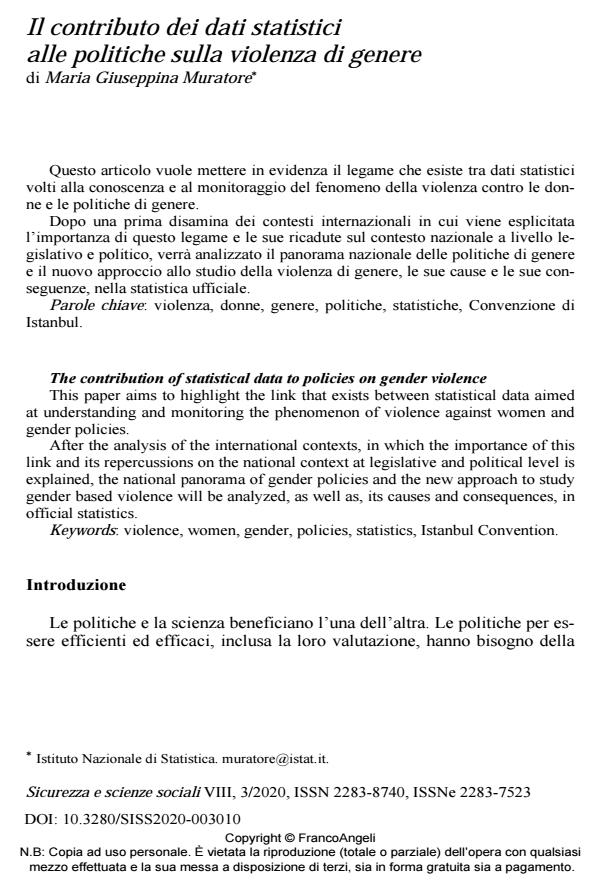Il contributo dei dati statistici alle politiche sulla violenza di genere
Titolo Rivista SICUREZZA E SCIENZE SOCIALI
Autori/Curatori Maria Giuseppina Muratore
Anno di pubblicazione 2021 Fascicolo 2020/3
Lingua Italiano Numero pagine 24 P. 129-152 Dimensione file 392 KB
DOI 10.3280/SISS2020-003010
Il DOI è il codice a barre della proprietà intellettuale: per saperne di più
clicca qui
Qui sotto puoi vedere in anteprima la prima pagina di questo articolo.
Se questo articolo ti interessa, lo puoi acquistare (e scaricare in formato pdf) seguendo le facili indicazioni per acquistare il download credit. Acquista Download Credits per scaricare questo Articolo in formato PDF

FrancoAngeli è membro della Publishers International Linking Association, Inc (PILA)associazione indipendente e non profit per facilitare (attraverso i servizi tecnologici implementati da CrossRef.org) l’accesso degli studiosi ai contenuti digitali nelle pubblicazioni professionali e scientifiche
Questo articolo vuole mettere in evidenza il legame che esiste tra dati statistici volti alla conoscenza e al monitoraggio del fenomeno della violenza contro le donne e le politiche di genere. Dopo una prima disamina dei contesti internazionali in cui viene esplicitata l’importanza di questo legame e le sue ricadute sul contesto nazionale a livello le-gislativo e politico, verrà analizzato il panorama nazionale delle politiche di genere e il nuovo approccio allo studio della violenza di genere, le sue cause e le sue conseguenze, nella statistica ufficiale.
Parole chiave:Violenza, donne, genere, politiche, statistiche, Convenzione di Istanbul.
- Muratore M.G. (2015). L’indagine sulla sicurezza dei cittadini, in “Navigando tra le fonti sociali”, Istat.
- Committee on the Elimination of Discrimination against Women (1989). General recommendation, No. 12.
- Committee on the Elimination of Discrimination against Women (1992). General recommendation, No. 19.
- Committee on the Elimination of Discrimination against Women (2017). General recommendation No. 35 on gender-based violence against women, updating general recommendation No. 19, 14 July.
- Council of Europe. (2011). Convention on preventing and combating violence against women and domestic violence, 12 April.
- European Statistical. (2020). System handbook for quality and metadata reports, -- https://ec.europa.eu/eurostat/documents/3859598/10501168/KS-GQ-19-006-EN-N.pdf.
- Istat. (2006). Il sistema di indagini sociali multiscopo. Istat, collana Metodi e norme, n.31.
- Istat. (2006). Violenza e maltrattamenti contro le donne dentro e fuori la famiglia. Statistica Report. -- https://www.istat.it/it/files//2011/07/testointegrale.pdf.
- Istat. (2008). La violenza contro le donne, Roma -- https://www.istat.it/it/archivio/213411
- Istat. (2015). La violenza contro le donne dentro e fuori la famiglia, -- https://www.istat.it/it/files//2015/06/violenze_contro_le_donne.pdf.
- Istat. (2020). Rapporto Sdgs. Informazioni statistiche per l’agenda 2030 in Italia -- https://www.istat.it/it/files//2020/05/SDGs_2020.pdf.
- Muratore M.G., and L. L. Sabbadini. (2005). Italian survey on violence against women” Statistical Journal of the United Nations ECE 22 (2005) 265–278, IOS Press.
- UN General Assembly. (1993). Declaration on the Elimination of Violence against Women. Resolution 48/104 of 20 December.
- UN General Assembly. (2012). Report of the Special Rapporteur on violence against women, its causes and consequences, Rashida Manjoo -- https://www.ohchr.org/Documents/HRBodies/HRCouncil/RegularSession/Session20/A-HRC-20-16-Add2_en.pdf.
- UN General Assembly. (2015). Resolution adopted by the General Assembly on 25 September.Transforming our world: the 2030 Agenda for Sustainable Development, -- https://www.un.org/ga/search/view_doc.asp?symbol=A/RES/70/1&Lang=E.
Maria Giuseppina Muratore, Il contributo dei dati statistici alle politiche sulla violenza di genere in "SICUREZZA E SCIENZE SOCIALI" 3/2020, pp 129-152, DOI: 10.3280/SISS2020-003010